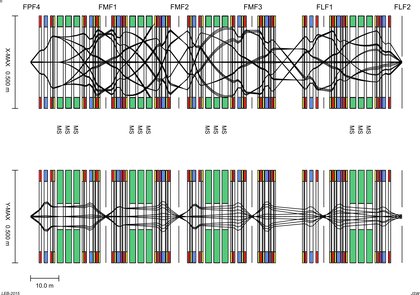Low-Energy Branch
The table below gives the 1st-order transfer matrix elements at the focal planes in the Low-Energy Branch of the Main-Separator after FMF3. The linear dimensions x and y are in meters, the angles a and b in radians, and the momentum deviation d as a fraction of the nominal (reference) value. The “path length” is from the Super-FRS target. FLF2 is 4 m from the end of the last quadrupole, FLF2QT32.
1st-order transfer matrix elements at the focal planes in the LEB.
Matrix element | FLF1 | FLF2 |
(x,x) | 3.67 | -2.00 |
(x,a) | ||
(x,d) | -5.57 | |
(a,a) | 0.27 | -0.50 |
(a,d) | ||
(y,y) | 1.49 | -2.01 |
(y,b) | 0.14 | -0.25 |
(b,b) | 0.35 | -0.22 |
Path length (m) | 175.04 | 180.72 |
The HISPEC/DESPEC experiments, including the gamma-tracking array AGATA, will be mounted at FLF3 and FLF4.
The principle of the Energy Buncher is that the momentum spread of the beam can be reduced if the resolving power ensures that the lateral spread in the beam is dominated by the dispersion and not by object magnification and aberrations. A specially-shaped wedge degrader at the dispersed focal plane FLF5 is used for this purpose.
The beams for the Energy Buncher start from FLF2 up to the end focus FLF6, where the cryogenic-gas stopping-cell will be located. Extracted beams from the stopping cell are sent to the MATS, LASPEC and other experiments.





